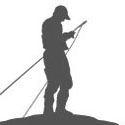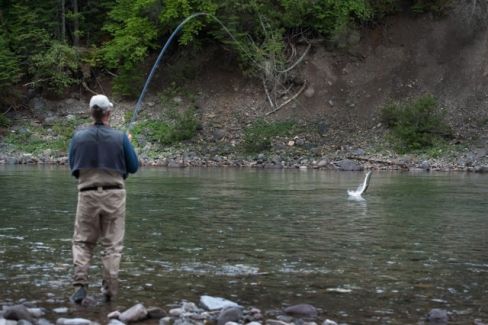Snow white capped mountains, crispy crystal
air, cold ginger clear waters flow placidly before the melting season arrives.
Below the surface, in the current, chromed shadows move quickly and silently.
In the northwest of British Columbia Canada it is springtime, between March and
mid May the last big steelheads rush the Skeena region’s rivers in search of
their spawning grounds.
This is my favorite steelhead fishing season of the year. Luckily enough to have my house and my lodge only a 10 minutes walk from the best steelhead stretch of lower Kalum River I can challenge these beauties all year long, but when it comes for strength and aggressiveness the spring’s beasts are second to no other fish.
The Skeena region hosts many of the world's best steelhead and salmon rivers that provide unsurpassed sport for any angler. For the spring run main targets will be on the Skeena, Kalum, Kitimat rivers and on other tributaries less known but equally productive.
The area is still very wild and the walk thru spots are few and often crowded therefore the best way to reach the fishing spots is by navigating the rivers with jet boat on the Skeena and Kalum, drifting the Kitimat with a nice drift boat or with a 8 or 9 feet pontoon boat. High experience is recommended when floating the rivers as logjam and other perils are waiting behind any river bend.
Water levels are at the lowest with clear ginger water, light/medium sinking rate lines setup are what you need, but keep in your bag heavy sinking stuff for deep water pools or in case the water levels rise. The best of all is that all fly-fishing techniques in all flavors are good to fish, but the spey casting it is probably the best option.
Rods weights, range from a 7 to 8 for double hand from 8 to 9 weight for single hand. Don’t forget to bring a five-weight rod for the time when you will hit a trout packed pool. Fishing with a minnow pattern for trouts could be a relaxing and enjoyable break. I personally use an 11 feet 7 weight switch rod with a floating Skagit header and a 10ft sinking tips from T8 to T14 or in alternative a Rio Mow tip 2.5-7.5 T14. I like this setup because is a very flexible system that allows me to challenge almost every fishing condition. The choice of the flies to use is a very sensitive and personal topic; from my experience I can say that all patterns from classic to modern work fine, the most important thing is that your fly bump directly on the nose of the angry steelhead. Pink in all the combination it is probably the best color for your fly dressing but don’t forget to include in you spring collection other color combination in black-purple, black-blue and black-orange. Even if I’m aware that are not always the best choice, I usually swing skinny big tube flies pattern; the way steelhead hit so hard and nastily the big fly it is something that I can’t resist.
At this time of the year the catches extravaganza is far away, salmons will start to show up by mid June with the mighty Chinooks first of the family to enter the rivers.
Anglers that come here in spring have in their mind and soul only the steelhead. They are in search of the excitement that only a fresh and aggressive steelhead of 5 -7 kg (11 – 15 lbs.) can give: head shaking, sky rocketing jumps, cart wheeling, runs as fast that you can imagine have made legendary the steelhead fights.
A pure shot of adrenaline that makes the body and the spirit to rock’n roll that you can’t help to asking for more and more.
That’s why they call it steelhead addiction
Hoppe you enjoyed reading these very personal considerations.
Tight lines
Francesco Guerriero
Facts (source wikipedia.org)
Specie: Oncorhynchus mykiss. The steelhead is a rainbow trout that
spends from one to five years in fresh water, and make long marine migrations
into the North Pacific and the Gulf of Alaska then returns to fresh water to
spawn. Spawning occurs in the spring, not all steelhead die after they spawn;
many return to the sea; some even make it back to spawn again.
Size:
Length: 50-85 cm max 120cm
Weight: 5 – 9 Kg max 21kg
Distribution
The exact distribution is controlled by cooler ocean temperatures, north of the 15°C isotherm, from southern California to Alaska Peninsula.
Runs:
They are broadly referred to as the summer-run and winter-run steelhead. The first enter fresh water from early spring to late fall of the year prior to spawning. Winter-runs enter the river from late fall to early spring. Summer-run fish enter the river while still immature and reach full maturity while holding in fresh water. Later winter-runs are fully mature when they arrive.















































































